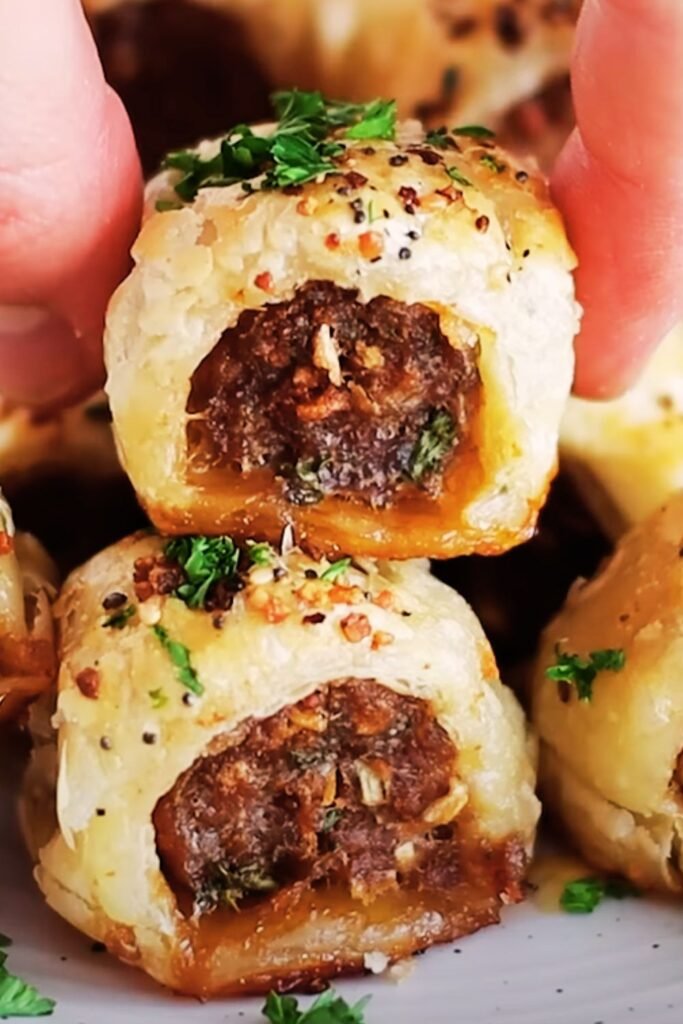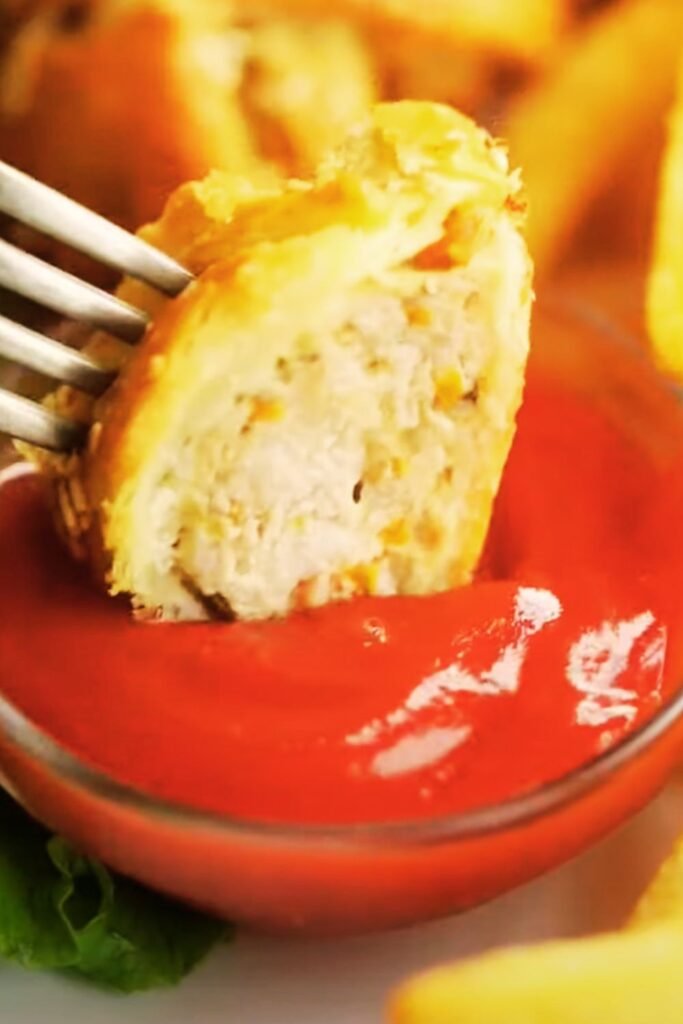When I first encountered the magical combination of caramelized French onions wrapped in flaky pastry alongside seasoned sausage meat, I knew I had discovered something truly special. These savory French onion sausage rolls represent the perfect marriage of classic British comfort food with sophisticated French flavor profiles, creating a dish that’s both familiar and excitingly different.
My journey with this recipe began during a particularly cold autumn evening when I was craving something warm, satisfying, and deeply flavorful. Traditional sausage rolls, while delicious, sometimes felt a bit one-dimensional to me. That’s when inspiration struck – why not incorporate the rich, sweet complexity of French onion soup into this beloved pastry format?
The result exceeded my wildest expectations. The slow-cooked onions, transformed through patient caramelization into golden, jammy sweetness, complement the savory sausage meat beautifully. Each bite delivers layers of flavor that unfold on your palate, from the initial buttery pastry crunch to the rich, umami-packed filling that follows.
Understanding the Components
French Onion Foundation
Caramelized Onions: The star ingredient that transforms ordinary sausage rolls into something extraordinary through slow cooking and patience.
Yellow Onions: Preferred variety for their balanced sweetness and sturdy structure that holds up during long cooking.
White Onions: Alternative option that provides sharper flavor notes and quicker caramelization.
Sweet Onions: Vidalia or Walla Walla varieties that offer natural sweetness and tender texture.
Sausage Selection Criteria
Italian Sausage: Provides robust flavor with fennel and herb notes that complement the onions beautifully.
Breakfast Sausage: Milder option that allows the French onion flavors to shine through prominently.
Chorizo: Spanish variety that adds smoky paprika notes and slight heat to the mixture.
Turkey Sausage: Leaner alternative that still delivers excellent flavor while reducing overall fat content.
Essential Ingredients Breakdown

| Ingredient Category | Specific Items | Quantity | Purpose |
|---|---|---|---|
| Pastry Base | Puff pastry sheets (frozen) | 2 sheets (1 lb total) | Crispy exterior shell |
| Egg wash (beaten egg + cream) | 1 egg + 2 tbsp cream | Golden brown finish | |
| Onion Component | Large yellow onions | 4 medium (2 lbs) | Primary flavor base |
| Butter (unsalted) | 4 tablespoons | Caramelization medium | |
| Brown sugar | 1 tablespoon | Accelerates caramelization | |
| Fresh thyme leaves | 2 teaspoons | Herbal complexity | |
| Bay leaves | 2 whole leaves | Aromatic depth | |
| Sausage Mixture | Ground Italian sausage | 1.5 lbs | Protein foundation |
| Breadcrumbs (fresh) | 1/2 cup | Binding agent | |
| Dijon mustard | 2 tablespoons | Tangy accent | |
| Fresh sage (chopped) | 1 tablespoon | Earthy flavor | |
| Seasonings | Kosher salt | 2 teaspoons | Flavor enhancement |
| Black pepper (fresh ground) | 1 teaspoon | Spice balance | |
| Garlic powder | 1 teaspoon | Aromatic support | |
| Paprika (sweet) | 1/2 teaspoon | Color and warmth |
Step-by-Step Preparation Process
Phase 1: Onion Caramelization Mastery
The foundation of exceptional French onion sausage rolls lies in properly caramelized onions. I’ve learned through countless attempts that rushing this process inevitably leads to disappointing results. The transformation from sharp, pungent raw onions to sweet, golden perfection requires patience and attention.
Begin by selecting your onions carefully. I prefer large yellow onions because they maintain their structure during the long cooking process while developing incredible sweetness. Slice them uniformly into half-moon shapes, roughly 1/4-inch thick. Consistency in size ensures even caramelization throughout.
Heat a large, heavy-bottomed skillet over medium heat. Add the butter and allow it to melt completely before introducing the sliced onions. The initial volume will seem overwhelming – don’t worry, as the onions will reduce dramatically during cooking.
Season immediately with salt, which helps draw out moisture and accelerates the breakdown process. Stir gently to coat all onions with butter and distribute the salt evenly. The key here is maintaining steady, moderate heat that allows gradual moisture evaporation without burning.
Phase 2: The Patience Game

After about 10 minutes, you’ll notice the onions beginning to soften and release their moisture. This is when many home cooks make the mistake of increasing heat to speed things up. Resist this temptation completely.
Continue cooking for 20-25 minutes, stirring occasionally, until the onions turn a light golden color. At this stage, add the brown sugar and fresh thyme leaves. The sugar helps accelerate caramelization while the thyme introduces aromatic complexity that elevates the final flavor profile.
The next 15-20 minutes are crucial. The onions will deepen from light gold to rich amber, developing that characteristic jammy consistency that makes French onion soup so irresistible. Stir more frequently during this phase to prevent sticking, but avoid over-mixing which can break down the onions too much.
When properly caramelized, your onions should be deep golden brown, almost mahogany in color, with a consistency similar to thick jam. They should taste intensely sweet with just a hint of sharpness remaining. Remove from heat and let cool completely before proceeding.
Phase 3: Sausage Mixture Assembly
While your onions cool, prepare the sausage component. Remove the sausage meat from casings if using links, breaking it into smaller pieces for easier mixing. In a large bowl, combine the sausage meat with fresh breadcrumbs, which serve as both a binding agent and moisture absorber.
Add the Dijon mustard, chopped fresh sage, garlic powder, paprika, salt, and freshly ground black pepper. Mix thoroughly but gently – overworking can make the final texture tough and dense. The mixture should hold together when pressed but not feel compact or heavy.
Fold in the cooled caramelized onions, distributing them evenly throughout the sausage mixture. This integration is critical for consistent flavor in every bite. Taste and adjust seasoning as needed, keeping in mind that the pastry will add richness without additional salt.
Assembly Techniques for Perfect Results
Pastry Preparation Protocol
Remove puff pastry from freezer 30-40 minutes before use, allowing it to thaw just enough to roll without cracking. Working with properly tempered pastry makes all the difference between professional-looking results and amateur disappointments.
On a lightly floured surface, roll each pastry sheet into a rectangle roughly 12 inches by 16 inches. The dough should be even in thickness throughout – approximately 1/8-inch thick works perfectly. Too thin and it won’t contain the filling properly; too thick and it becomes doughy rather than crispy.
Filling Distribution Strategy

Divide your sausage and onion mixture into two equal portions. Working with one pastry sheet at a time, create a log of filling along the long edge, leaving about 1 inch of pastry border on three sides. The filling should be compact but not compressed, maintaining some air pockets for better texture after baking.
Brush the opposite long edge with egg wash, then carefully roll the pastry over the filling, creating a seam on the bottom. Press gently to seal, ensuring no air bubbles remain trapped inside. The seam should be tight but not stretched, which could cause splitting during baking.
Baking Science and Temperature Control
Optimal Baking Conditions
Preheat your oven to 425°F (220°C) with racks positioned in the upper and lower thirds. This temperature provides the perfect balance between cooking the sausage thoroughly and achieving golden, flaky pastry.
Line two large baking sheets with parchment paper, which prevents sticking and ensures even browning. Transfer the assembled rolls to the prepared sheets, seam-side down. Using a sharp knife, score the tops at 2-inch intervals, cutting about halfway through the pastry. This scoring serves dual purposes: it creates attractive serving portions and provides steam vents during baking.
Temperature and Timing Precision
| Baking Stage | Temperature | Duration | Visual Cues |
|---|---|---|---|
| Initial Bake | 425°F (220°C) | 15 minutes | Light golden color, beginning to puff |
| Rotation | 425°F (220°C) | 5 minutes | Even browning check, rotate pans |
| Final Phase | 400°F (205°C) | 10-12 minutes | Deep golden brown, crispy texture |
| Rest Period | Room temperature | 5-10 minutes | Internal temperature 160°F (71°C) |
Brush the tops generously with egg wash before baking, which creates that beautiful golden sheen characteristic of professional pastries. Avoid over-brushing, which can cause pooling and uneven coloration.
Serving Suggestions and Pairing Ideas
These savory French onion sausage rolls shine in various serving contexts, from casual family dinners to elegant entertaining scenarios. I’ve served them at countless gatherings and consistently receive requests for the recipe.
Hot Serving Presentations
Immediately after baking, while still warm, these rolls offer the ultimate comfort food experience. The pastry maintains maximum crispiness, and the filling remains juicy and flavorful. Cut into individual portions using the scored lines as guides, arranging on a warming platter for buffet-style service.
Accompany with small bowls of whole grain mustard, fig jam, or caramelized onion chutney for guests who appreciate additional flavor complexity. A simple side salad of mixed greens with light vinaigrette provides fresh contrast to the rich pastry.
Cold Service Options
Surprisingly, these rolls excel as cold appetizers or picnic fare. The flavors meld and intensify overnight, creating a different but equally delicious experience. Cut into smaller, bite-sized portions for cocktail party service, garnishing each piece with a small sprig of fresh herbs.
Storage and Reheating Strategies
Short-Term Storage Solutions
Refrigeration Method: Wrap cooled rolls tightly in plastic wrap or store in airtight containers for up to 3 days. The pastry will soften slightly but maintains excellent flavor.
Counter Storage: At room temperature, consume within 24 hours for food safety and optimal quality.
Long-Term Preservation
Freezing Raw Rolls: Assemble completely but freeze before baking. Wrap individually in plastic wrap, then place in freezer bags. Bake directly from frozen, adding 5-10 minutes to cooking time.
Freezing Baked Rolls: Cool completely before wrapping and freezing. Keeps for up to 3 months with minimal quality loss.
Reheating Techniques
| Method | Temperature | Time | Results |
|---|---|---|---|
| Oven Reheat | 350°F (175°C) | 8-10 minutes | Restores crispiness effectively |
| Toaster Oven | 350°F (175°C) | 5-7 minutes | Perfect for single servings |
| Air Fryer | 350°F (175°C) | 3-5 minutes | Excellent crispiness restoration |
| Microwave | Medium power | 30-60 seconds | Quick but softens pastry |
Troubleshooting Common Issues
Through my experience making these rolls countless times, I’ve encountered and solved various challenges that home cooks frequently face.
Soggy Bottom Prevention
The most common complaint involves soggy pastry bottoms, usually caused by insufficient oven temperature or excess moisture in the filling. Ensure your oven reaches full temperature before baking, and always drain any excess liquid from the cooled onions before mixing with sausage.
Filling Leakage Solutions
Proper sealing techniques prevent filling from escaping during baking. Avoid overfilling, ensure pastry edges are dry before sealing, and press seams firmly without stretching the dough. If leakage occurs, it’s often because the filling was too warm when assembled.
Uneven Browning Corrections
Rotating pans halfway through baking ensures even coloration. If one end browns faster than the other, your oven has hot spots – note their location for future reference and adjust pan positioning accordingly.
Nutritional Considerations and Modifications
Traditional Recipe Nutrition
Each serving (assuming 8 servings per batch) contains approximately:
- Calories: 420
- Protein: 18g
- Carbohydrates: 28g
- Fat: 26g
- Fiber: 2g
- Sodium: 680mg
Healthier Adaptations
Turkey Substitution: Replace Italian sausage with ground turkey seasoned with fennel, garlic, and red pepper flakes. Reduces calories by roughly 15% while maintaining excellent flavor.
Whole Wheat Pastry: Some specialty stores carry whole wheat puff pastry, adding fiber and nutty flavor complexity.
Vegetarian Version: Substitute sausage with seasoned mushroom and walnut mixture, maintaining protein content while eliminating meat entirely.
Seasonal Variations and Creative Adaptations
Spring Modifications
Incorporate fresh herbs like chives, tarragon, or dill into the sausage mixture. Add finely diced spring onions along with caramelized regular onions for textural contrast and sharper flavor notes.
Summer Adaptations
Include sun-dried tomatoes and fresh basil in the filling, creating a Mediterranean-inspired variation that pairs beautifully with warm-weather dining.
Fall Enhancements
Add diced apples to the onion mixture during the last 10 minutes of caramelization, introducing subtle sweetness and seasonal appeal. Sage becomes particularly appropriate during autumn months.
Winter Comfort Versions
Incorporate roasted garlic paste and extra herbs for deeper, more warming flavors that complement cold-weather appetites.
Questions & Answers
Q: Can I prepare the onions several days in advance?
Absolutely! Caramelized onions actually improve in flavor after a day or two in the refrigerator. Store them in an airtight container and bring to room temperature before mixing with the sausage. This make-ahead approach actually saves significant time during final assembly.
Q: What’s the best way to prevent the pastry from becoming soggy?
The key is ensuring your onions are completely cooled and well-drained before mixing with the sausage. Any residual heat or excess moisture will steam the pastry from the inside. I also recommend baking on the upper oven rack for the first 15 minutes to promote bottom browning.
Q: Can I use store-bought caramelized onions instead?
While possible, I strongly recommend making your own. Store-bought versions often contain preservatives and lack the depth of flavor achieved through slow, careful cooking. The time investment really pays off in the final taste.
Q: How do I know when the sausage is fully cooked?
The internal temperature should reach 160°F (71°C) throughout. If you’re concerned about doneness, make your rolls slightly thinner or bake at a lower temperature (375°F) for a longer period to ensure even cooking.
Q: Can I make mini versions for appetizers?
Definitely! Cut each pastry sheet into smaller rectangles and reduce filling accordingly. Bake for 12-15 minutes at the same temperature, watching carefully to prevent over-browning. Mini versions are perfect for cocktail parties.
Q: What’s the secret to getting perfectly golden pastry?
The egg wash makes all the difference. Beat one whole egg with 2 tablespoons of heavy cream until smooth, then brush evenly over the pastry surface. Avoid pooling, which can cause uneven browning or soggy spots.
Q: How far in advance can I assemble these before baking?
Assembled rolls can be refrigerated for up to 24 hours before baking. Cover tightly with plastic wrap to prevent the pastry from drying out. Add 3-5 minutes to the baking time if starting from cold.
Q: Can I substitute the puff pastry with pie crust?
Puff pastry creates the signature flaky layers that make these rolls special. Pie crust would work functionally but won’t provide the same textural experience. If you must substitute, use a butter-rich pie crust recipe for best results.
These savory French onion sausage rolls represent everything I love about comfort food – they’re deeply satisfying, endlessly adaptable, and guaranteed to impress. The combination of techniques might seem complex initially, but each component is straightforward when broken down into manageable steps.
My advice is to embrace the process, especially the onion caramelization phase. That golden, jammy sweetness transforms an ordinary sausage roll into something truly extraordinary. Whether you’re preparing them for a special occasion or simply treating your family to something delicious, these rolls deliver comfort and sophistication in every bite.